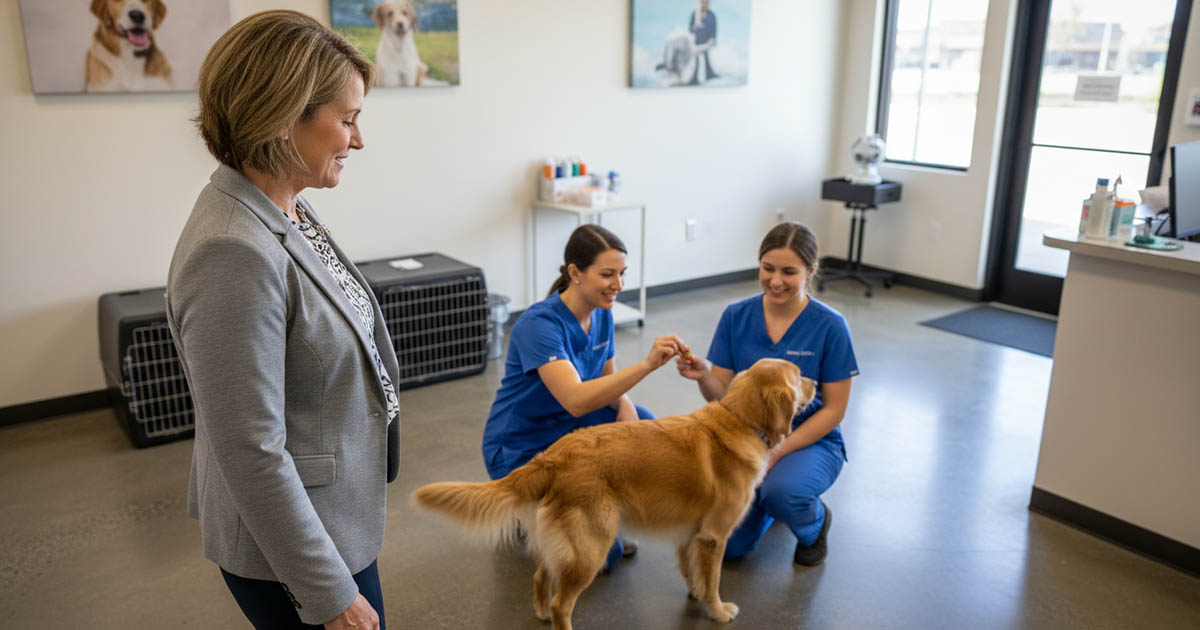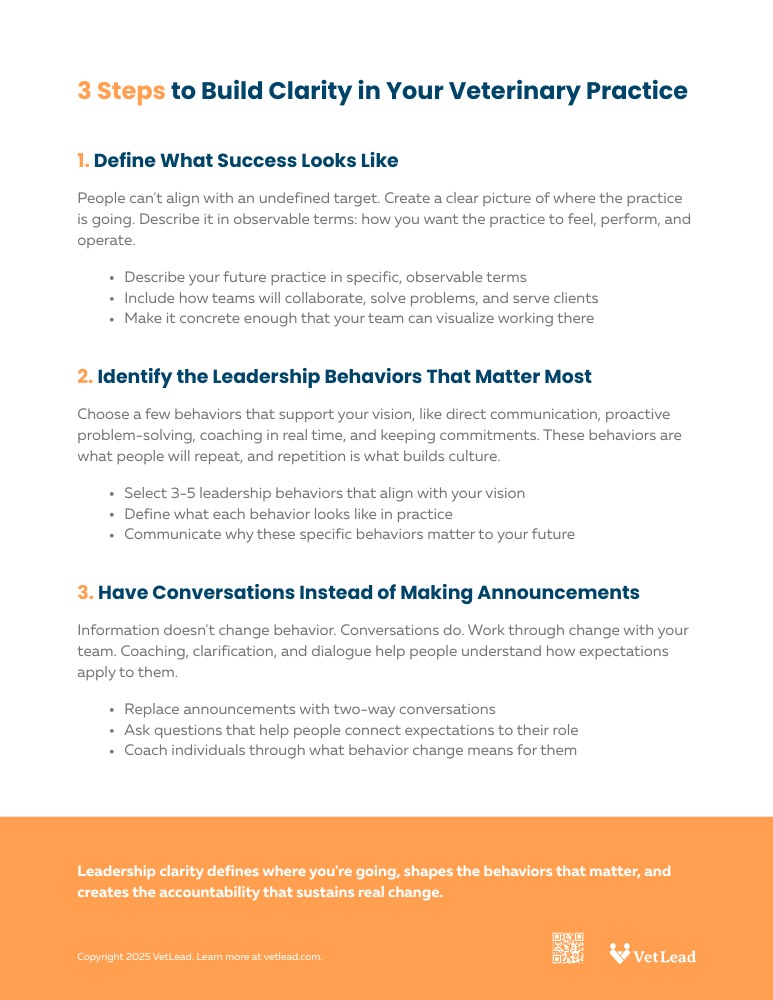The most successful veterinary practices aren’t the ones with the newest equipment or the most exam rooms. They are the ones where leaders create clarity. When people understand what the future looks like and how they contribute to it, performance improves. When they don’t, the practice spends most of its time reacting instead of advancing.
Anyone who makes decisions for a practice feels this pressure. Owners, veterinarians, and practice managers all carry the responsibility of creating a place where teams can do great work. Clarity is part of what makes that possible.
When You Stay Focused on Today, the Practice Stops Moving Forward
You spend a lot of time solving problems. That’s part of the job. The challenge comes when today's problems take up so much space that the future never gets defined.
You can probably describe every detail of what went wrong last week or last month. You can list every current staffing issue, workflow breakdown, or client complaint. But if asked about the future, is the picture as detailed and complete?
Lack of Clarity Slows Down Operations
When you can’t describe where the practice is going, your team fills that gap with assumptions. People focus on getting through the day. They wait for instructions instead of anticipating what is needed next. Team members hesitate to solve problems because they are unsure what a good solution looks like.
That slows everything down and places more weight on you. Without clarity, you become the filter for every decision, every disagreement, and every step forward. Your veterinary hospital depends on you instead of the systems, expectations, and leadership habits you build.
Culture Is Built Through Behaviors, Not Good Intentions

Every veterinary practice has a culture. The question is whether it formed by design or by default. Culture is simply the collection of behaviors your team repeats. It’s how people communicate, how they solve problems, and how they treat each other.
If the default culture in a practice includes gossip, avoidance, and silent frustration, those habits eventually feel normal, shaping how information flows, how conflicts are handled, and how the team supports clients. Those habits cost you through turnover, client dissatisfaction, and rework.
Creating an Intentional Culture in Your Veterinary Practice
If the culture is intentional, the opposite happens. You define the behaviors that matter. Direct communication replaces gossip. Collaboration replaces silos. Accountability replaces blame. These behaviors create a work environment that supports consistency, teamwork, and predictable performance.
This kind of culture reduces the number of fires you have to put out. It builds trust. It lowers turnover. It lets you focus more of your time on guiding the practice instead of managing interpersonal friction.
Sustainable Practices Build Leadership Habits on Purpose
Leadership is not a personality trait. It is a set of repeatable behaviors. Practices that understand this build leadership just like they build medical excellence, creating clear expectations for leaders, defining the habits that matter, and supporting those habits with structure and communication.
If the default culture in a practice includes gossip, avoidance, and silent frustration, those habits eventually feel normal.
Practices that don’t do this drift. Leaders rely on instinct instead of clarity. Teams depend on individual personalities instead of consistent expectations. Processes break down. Culture becomes unpredictable. Results flatten.
You feel the effects of a drifting practice. Days feel harder. Problems feel familiar. Growth feels stalled. The team works hard, but the outcomes don't change.
Leadership clarity is what breaks that cycle.
Three Steps to Build Leadership Clarity
1. Define What Success Looks Like 12 to 24 Months From Now
People can’t align with an undefined target. Create a clear picture of where the practice is going. Describe it in observable terms. Talk about how you want the practice to feel, perform, and operate.
This gives your team direction. It gives every leader a filter for decision-making. It turns daily choices into steps toward a defined future instead of reactions to immediate pain.
2. Identify the Leadership Behaviors That Matter Most
Choose a few behaviors that support your vision. Examples include direct communication, proactive problem-solving, coaching in real time, and keeping commitments. These behaviors are what people will repeat, and repetition is what builds culture.
When everyone understands the leadership habits you value, people know how to show up. They know how to think and act in a way that supports the practice.
3. Hold Conversations Instead of Delivering Announcements
Information doesn’t change behavior. Conversations do. You need to work through change with your team. Coaching, clarification, and dialogue help people understand how expectations apply to them.
These conversations build ownership. They remove hesitation. They create alignment.

Build Clarity in Your Veterinary Clinic
Download this free resource and use it to evaluate how you approach recruiting and hiring. No email address required.
Accountability and Coaching Drive Better Results
Those three steps work when your practice is built on accountability. Not the kind that shows up after something goes wrong, but the kind that shows up before mistakes ever happen. Accountability is the mindset that says, "I own what I produce here. My work matters. The outcomes matter."
When people operate from that mindset, they solve problems without waiting. They look ahead. They take responsibility for the success of the team.
How Coaching Builds Accountability Throughout Your Hospital
Coaching amplifies this. Effective coaching helps people think through challenges, build new skills, and adjust habits that are holding them back. Without coaching, practices rely on repetition. With coaching, practices rely on capability.
This matters because it directly affects your workload. When leaders coach well, fewer issues climb up the hierarchy. The team becomes more capable, more adaptable, and more confident. You spend less time putting out fires and more time building a practice that moves forward.
Clarity Is Not Optional for Practices That Want to Grow
Leadership clarity is what moves a practice forward. It defines where you're going, shapes the behaviors that matter, and creates the accountability that sustains real change. When those pieces align, performance improves and the practice becomes what you designed it to be.
You don’t need more rules or more meetings. You need a clear picture of where the practice is going and the leadership habits that move it forward. When that clarity exists, teams become more capable, days become more predictable, and the practice becomes a place where people can succeed together.
This is how veterinary practices grow in healthy, sustainable ways. Clarity is where it starts. Consistent leadership habits keep it moving. The results become evident in every interaction, every patient visit, and every result you produce together.
What do you think? Other veterinary pros want to hear from you! Share your experience in the comments below.